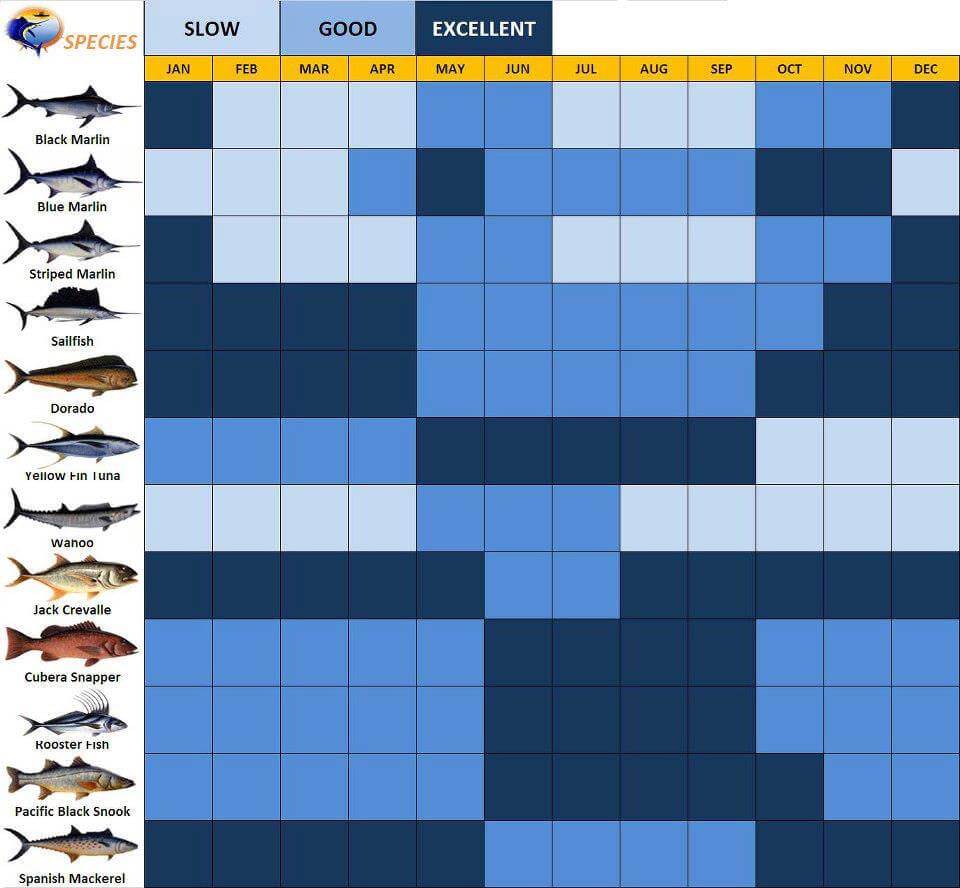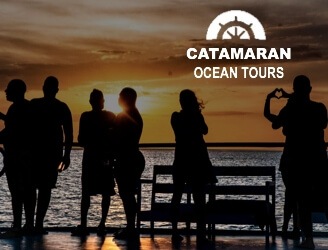Fishing Guideline & Chart of Costa Rica – AskZipy
Fishing Guide for Costa Rica- Places, Seasons and Types of Fish
Costa Rica is undoubtedly the angler's pride. From the snout marlin and vibrant sailfish to the world-famous tuna, all the big varieties of fish are widely spread across the coastal regions of Costa Rica. One of the most alluring sport fishing thrills in Costa Rica is to catch some of the largest and fastest-moving fish which are various types of Marlin, Sailfish and other big game fish, which are seen in different coastal regions throughout the year. The Pacific ports and beach resorts are best known for deep-sea fishing whereas the North Atlantic Coast provides abundant opportunities for world-class tarpon and snook fishing.
Before you are all set to go ahead for this exciting sail, you should be aware of some of the essential aspects of fishing in Costa Rica. Sport fishers in Costa Rica are required to have a fishing license, which is usually provided by the boat charter that you select.
Fishing tours in Costa Rica are always rewarding when you are aware of the conducive coastal fishing regions and the suitable season to catch some special varieties. Here is a comprehensive fishing guide of Costa Rica to help you choose some of the best locations for fishing specific varieties in the right season.
The Pacific Region
Fishing spots in the Pacific Ocean are divided into three zones; North, Central and South Pacific.
Fishing in North Pacific Costa Rica
The North Pacific region stretches from the Nicaragua border to the Nicoya Peninsula. Many charters sail across the Playa Flamingo marina, a sportfishing centre up to Tamarindo, a beach town, which is popular for its nightlife. Other charters in the northern region are available in Playa del Coco, Octal, Brasilito and Potrero. Fishing boats also operate in the southern Pacific regions such as Garza, Samara, Nosara and Carrillo, which receive better wind protection from late December to April. Most of these fishing spots are surrounded by beach resorts where fishing charters are easily accessible. Fishing services can be reached through the local directory of Costa Rica, which provides contact details of special fishing tour operators.
The type of fish in the North Pacific Region and the fishing seasons are as follows:
Marlin: August to September is the peak season for fishing Marlin. Mid-November to March are exceptional months when this variety is hard to find but the population gradually increases from April to early June.
Blue Marlin: Found in the northwest region from May to September when the school moves northwards with drier weather and warm waters.
Black Marlin: Found in the Guanacaste region from April to September.
Striped Marlin: Found in small numbers throughout the year but more during the winter months and come close to shore with warm currents.
Sailfish: The best season to catch the sailfish is from May to August. This variety declines from August to November but is otherwise available throughout the year.
Yellow Fin Tuna: Available throughout the year, the peak season being from August to November. Yellow-fin and big-eye, which weigh between 5 kg to 80 kg are found in abundance between Catalina Islands and Tamarindo.
Dorado: Commonly known as dolphin, this variety is abundant from late May to October, during the rainfall season.
Wahoo: Seen in the first rain showers of May and later found in plenty during the peak season from July to August. Wahoo is mostly caught near islands, rocky points and occasionally at the offshore.
Roosterfish: The best place to fish this variety is in Golfo de Papagayo from November to March. Roosterfish swim at a depth of 15-18 ft.
Jack Crevalle: Available in large quantities throughout the year and negligible in June and July.
Cubera Snapper: The best season for fishing this variety is from July to December and can be found in-shore and offshore around rocky structures and reefs.
Pacific Black Snook: Occasionally found from January to April.
Spanish Mackerel: *not available in the Northern Pacific Region.
Fishing in Central Pacific Costa Rica
This region covers the Nicoya Peninsula in the north to Drake Bay below, which is few kilometres away from Corcovado National Park. Fishing in Los Suenos is an enriching experience with its world-class marina making it the 'fishing capital' of Costa Rica. Los Suenos is a few hours drive from San Jose International Airport. Fishing in Quepos is a favourable option out of the new Pez Vela Marina which is close to Manuel Antonio National Park and can be reached via road or a domestic flight from San Jose. Multi-day trips can be arranged for fishing in Manuel Antonio, Quepos and Drake Bay. These places are famous for sailfish, marlin, tuna, snapper, cubera, roosterfish and many other varieties.
The type of fishes in Central Pacific and the fishing seasons are as follows:
Marlin: The peak season for this variety is from September to November. Blue and black marlin are caught throughout the year but are far from boats catching sailfish.
Blue Marlin: The best season for this variety is from November to January and are found in abundance along coastal regions of Jaco, Manuel Antonio and Osa Peninsula.
Black Marlin: Start peaking from July till August and the best season is from December to February.
Striped Marlin: Caught throughout the year, primarily around Golfito and Quepos areas.
Sailfish: The best season is the migration period from mid-December to April. However, large numbers are seen in October. Sailfish are seen near the shore with other fish varieties from June to September
Roosterfish: They are seen in plenty from June to early September near river mouths and rocky sides. Parrita River, Damas, Naranjo River, Drake Bay and Cano Island are some hot spots to catch roosterfish.
Yellow Fin Tuna: Seen throughout the year, but the peak season is from June to September. Tuna of 5 kg to15 kg is the most common in this region but monster sizes, which weigh up to 90 kg are occasionally seen.
Dorado: Peak season for Dorado is from May to October, during the wet season. They are clearly visible near floating timber pieces and usually run in large schools. Dorado is otherwise seen in negligible numbers throughout the year.
Wahoo: These are difficult to find in waters around Herradura or Quepos. Wahoo is exclusively found in Drake Bay during the peak season from June to August.
Cubera Snapper: This variety is available in abundance throughout the year. Fishing in Jaco is favourable for catching bigger sizes.
Spanish Mackerel: This is an all-year-round variety, which is seen close to the shores of Jaco and Manuel Antonio.
Pacific Black Snook: Occasionally found near river mouths from January to April.
Jack Crevalle: This variety is available in large quantities throughout the year
Fishing in South Pacific Costa Rica
South Pacific region covers fishing in Golfito, Golfo Dulce, Osa Peninsula, Puerto Jiminez and Drake Bay. Many fish varieties like marlin, sails, wahoo, roosters, snapper and amberjack are closer to the shore. Mackerel, snook and sea bass can be caught around the rock shoreline of Golf Dulce. Fishing in the Zancudo peninsula is preferred for snook. Golfito has two modern marinas which are less crowded than the Central and Northern areas and are very close to San Jose Airport.
The type of fishes in the South Pacific region and the fishing seasons are as follows:
Sailfish: The peak season of this variety is from December to March when they migrate towards the north. Sailfish are seen in thin numbers from May to June but start peaking by August.
Marlin: The best season to catch marlin is from August to December. Blue, black and striped marlin can be caught throughout the year when the water is warm.
Blue Marlin: Best Season is from November to January.
Black Marlin: December to February is the best season and July and August is the second-best season.
Striped Marlin: Found near continental shelves, ocean mountains and canyons throughout the year.
Roosterfish: The South Pacific region of Costa Rica is renowned for Roosterfish seen throughout the year. Kayak fishing in Puerto Jiminez is famous among tourists to catch this variety.
Yellow Fin Tuna: Tuna is available across Costa Rica offshore. Schools of up to 16 kg tunas are seen throughout the South Pacific coast year-round.
Dorado: Caught from May to October near the rivers when weed lines are the thickest.
Wahoo: These are caught throughout the year with billfish and near the reefs of Matapalo Cape.
Pacific Black Snook: Seen in large numbers from March to May and occasionally in July. Smaller sizes are caught year round.
Cubera Snapper: Huge Cubera snapper of 50 to 80 pounds are famous in this region. These are caught throughout the year near rocks, reefs and river mouths.
Spanish Mackerel: Available throughout the year, but most commonly seen near Jaco and Manuel Antonio.
Jack Crevalle: Found in large quantities throughout the year.
Fishing in Caribbean Costa Rica
The best fishing places on the Caribbean coast are near the rivers and the canals. One can find plenty of tarpon here, which weigh in the range of 36-68 kg. Many fishing lodges in Barra del Colorado, Tortuguero and Parismina are situated near the fishing canals. Houseboats for mobile fishing are available in some rivers and lakes. Tarpon fishing near the river mouths of the Caribbean is in full action from May to October and June to July in Barra del Colorado and Tortuguero. Snook fishing is common from October to December. Other small fishes in this region are goliath groper, Atlantic fish and small tuna. Fishing locations in the Caribbean are isolated and one may need to hire a vehicle to reach till the fishing spots.
The type of fishes in the Caribbean region and the fishing seasons are as follows:
Tarpon: This variety is the speciality of the Caribbean and is seen throughout the year. The peak season of tarpon is from May to November, near the offshore. Tarpon can also be found near river mouths and canals.
Snook: Big snook is caught in two seasons from March to May and from September to November.
Spanish Mackerel: This variety is found in plenty throughout the year.
Calba: These are smaller types of snook, which are active from November to January.
Billfish: These are occasionally seen throughout the year but the peak season is from February to September.
Wahoo: Found in plenty near the offshore from February to mid-June.
Dorado: Often found near river mouths throughout the year especially during runoff from the rivers.
Tripletail: This is a special variety of this region available from January to June.
Marlin: *Not available
Sailfish: * Not Available
Yellow Fin Tuna: * Not Available
Cubera Snapper: *Not Available
Roosterfish: *Not Available
Varieties like Jack Crevalle, Kingfish, Barracuda are caught near the shore any time of the year when the ocean is calm.
Fishing Chart of Costa Rica







